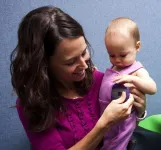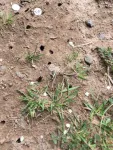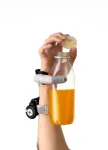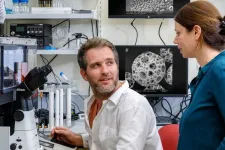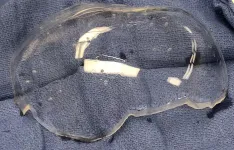(Press-News.org) In the first large-scale observation with human coding of infant vocalizations using all-day home recordings, babies of all ages from birth up to a year old squealed and growled in significant cluster patterns, suggesting the babies may have been actively engaged in noisemaking play and sound practice, according to a study published May 29, 2024 in the open-access journal PLOS ONE by Hyunjoo Yoo from the University of Alabama, Pumpki Lei Su from the University of Texas at Dallas, and colleagues.
In their first year of life, babies spend a remarkable amount of time vocalizing—both responding with noises to parents and caregivers, as well as self-directed babbling that could be considered vocal play, or exploration. Researchers have identified the most common baby phonation categories as vocants, or vowel-like sounds; squeals; and growls. Here, Yoo, Su, and colleagues investigate whether babies group specific noises in a non-random way, which would suggest practice or play.
The authors analyzed recordings from 130 English-learning, normally-developing babies recorded all day in their own homes in their first year of life by caregivers (taken from a larger study conducted by the Marcus Autism Center, Children’s Healthcare of Atlanta, and Emory University School of Medicine). 21 five-minute samples were randomly chosen from each infant recording. The authors parsed each vocalization made in every sample into vocants, squeals, and growls (as well as “other” sounds).
40 percent of all analyzed squeals and growls appeared in significant clusters across all infants. Over 60 percent of the 5-minute sessions showed a significant amount of clustering focusing on either squeals or growls, not both in one session. 87 percent of infants showed at least one age where their recordings had significant squeal clustering and at least one age where their recordings had significant growl clustering, with no infants demonstrating no clustering.
The authors note their sound categorizing approach, while enabling them to collect a large amount of data, likely oversimplified complexities and nuances in vocalizations. However, the quantitative dataset gathered here is sufficient to see clear patterns in individual babies as well as across the entire group, suggesting a possible pathway for language development warranting further investigation.
The authors add: “Active vocal exploration and vocal category formation are fundamental to subsequent language development. The present study represents the first empirical investigation of early vocal category formation. Infants not only spontaneously produce speech-like vocalizations, but also actively explore and practice different types of vocalizations from the first months of life.”
#####
In your coverage please use this URL to provide access to the freely available article in PLOS ONE: https://journals.plos.org/plosone/article?id=10.1371/journal.pone.0299140
Citation: Yoo H, Su PL, Ramsay G, Long HL, Bene ER, Oller DK (2024) Infant vocal category exploration as a foundation for speech development. PLoS ONE 19(5): e0299140. https://doi.org/10.1371/journal.pone.0299140
Author Countries: USA, Austria
Funding: The research for this manuscript was funded to DKO and GR by the National Institutes of Health grants (R01 DC015108) from the National Institute on Deafness and Other Communication Disorders (https://www.nidcd.nih.gov/). The research for this manuscript was funded to GR by the National Institutes of Health grants (P50 MH100029) from the National Institute of Mental Health (https://www.nimh.nih.gov/). The funders had no role in study design, data collection and analysis, decision to publish, or preparation of the manuscript. Training grant information: Helen Long NICHD T32HD007489 (Role: Trainee) NICHD U54HD090256 (Role: Trainee)
END
Babies babble squeals and growls in clustering patterns observable from birth through the first year, suggesting this active vocal exploration is important to speech development
2024-05-29
ELSE PRESS RELEASES FROM THIS DATE:
The sweat bee, H. rubicundus, is less sociable in Scotland than in Cornwall, but is genetically differentiated and genetically isolated too
2024-05-29
The sweat bee, H. rubicundus, is less sociable in Scotland than in Cornwall, but is genetically differentiated and genetically isolated too
###
Article URL: https://journals.plos.org/plosone/article?id=10.1371/journal.pone.0302688
Article Title: Genetic differentiation at extreme latitudes in the socially plastic sweat bee Halictus rubicundus
Author Countries: Netherlands, UK
Funding: This work is part of a project that received funding from the European Research Council (ERC) under the European Horizon's 202 research and innovation programme (grantagreement no. 695744). RAB was funded by a Wageningen Graduate School Postdoctoral Talent fellowship and a BBSRC discovery ...
Smartphone use may help adolescents feel better - at least in the moment, finds real-time survey of US teens
2024-05-29
Smartphone use may help adolescents feel better - at least in the moment, finds real-time survey of US teens
###
Article URL: https://journals.plos.org/plosone/article?id=10.1371/journal.pone.0298422
Article Title: Real-world adolescent smartphone use is associated with improvements in mood: An ecological momentary assessment study
Author Countries: USA
Funding: This study used data from a larger project that was funded by a stand-alone research agreement between Facebook's Youth Research Fund (2018-2020, Facebook, Inc.) ...
Public have no difficulty getting to grips with an extra thumb, study finds
2024-05-29
Cambridge researchers have shown that members of the public have little trouble in learning very quickly how to use a third thumb – a controllable, prosthetic extra thumb – to pick up and manipulate objects.
The team tested the robotic device on a diverse range of participants, which they say is essential for ensuring new technologies are inclusive and can work for everyone.
An emerging area of future technology is motor augmentation – using motorised wearable devices such as exoskeletons or extra robotic body parts to advance our motor ...
Breakthrough in cancer prediction with nano informatics and AI
2024-05-29
A recent study has introduced a novel method combining nano informatics and machine learning to precisely predict cancer cell behaviors, enabling the identification of cell subpopulations with distinct characteristics like drug sensitivity and metastatic potential. This research could transform cancer diagnosis and treatment, enhancing personalized medicine by facilitating rapid and accurate testing of cancer cell behaviors from patient biopsies and potentially leading to the development of new clinical tests to monitor disease progression and treatment effectiveness.
In an important advance in the fight against ...
New immunotherapy could treat cancer in the bone
2024-05-29
A new type of immunotherapy, developed by UCL researchers, has shown promising preclinical results against a bone cancer called osteosarcoma, as part of a study in mice.
Osteosarcoma is the most common bone cancer in teenagers but is still relatively rare, with around 160 new cases each year in the UK. Meanwhile, more than 150,000 people suffer from cancer that has spread to the bones.
Cancer that starts in or spreads to the bones is particularly hard to treat, meaning that it is a leading cause of cancer-related death. ...
USC researchers pioneer new brain imaging technique through clear “window” in patient’s skull
2024-05-29
In the first study of its kind, researchers from the Keck School of Medicine of USC and the California Institute of Technology (Caltech) designed and implanted a transparent window in the skull of a patient, then used functional ultrasound imaging (fUSI) to collect high-resolution brain imaging data through the window. Their preliminary findings suggest that this sensitive, non-invasive approach could open new avenues for patient monitoring and clinical research, as well as broader studies of how the brain functions.
“This is the first time anyone had applied ...
Rahimi Wins CAREER Award for Electrochemical Carbon Capture Research
2024-05-29
HOUSTON, May 29, 2024 – Mim Rahimi, an assistant professor of civil and environmental engineering at the University of Houston, has received a National Science Foundation CAREER award for his research proposal focusing on liquid-liquid interfaces for electrochemical carbon capture research.
His research proposal is “Leveraging Liquid-Liquid Interfaces for Innovative Electrochemical Carbon Capture.” It was selected for $537,719 in funding, with research running through August 2029.
“The project ...
As racial diversity and income rise, civilian injuries by police fall
2024-05-29
An analysis of civilian injuries resulting from interactions with police in Illinois found that residents of all races and ethnicities are more likely to sustain injuries if they live in economically under-resourced areas. The risk of injury decreases as communities become more racially diverse, the researchers found.
The study from the University of Illinois Chicago analyzed information on nearly 5,000 injuries caused by police that were treated in Illinois hospitals between 2016 and 2022. The researchers then compared that information with socioeconomic data from the U.S. Census on each injured person’s home ZIP code. The study is published in the ...
Mason CARES intervention reduces stress and feelings of burden of family caregivers of older adults with dementia
2024-05-29
According to the U.S. Centers for Disease Control and Prevention, 80% of those living with dementia receive informal care from family members or friends. This equates to 16 million family caregivers in the U.S. However, caring for family members with dementia is often associated with increased caregiver burden (which includes emotional, physical, and financial strain), stress, and worse physical health for the caregiver.
A recent study published in the Journal of Applied Gerontology, led by George Mason University researchers, found that a 9-week online stress ...
Fatal attraction: When endangered species try to mate with domestic relatives, both wildlife and people lose
2024-05-29
Sticks and stones aren’t enough to thwart biological attraction, but sometimes those are the only tools available to pastoralists trying to prevent wildlife from eloping with their livestock.
A new study led by Colorado State University brings awareness to both the human impacts of these encounters – ranging from economic loss to death – and conservation concerns for the wild animals that are often endangered.
Conserving threatened and endangered species is a globally recognized priority, but justice and equity for the marginalized pastoralist populations around the world who experience conflict with these species are often ...
